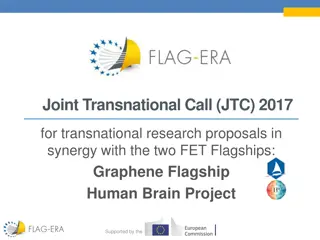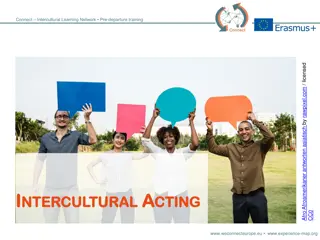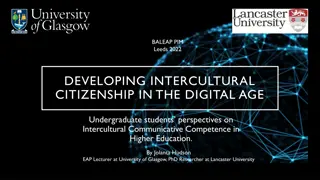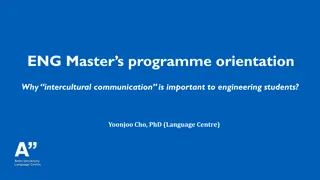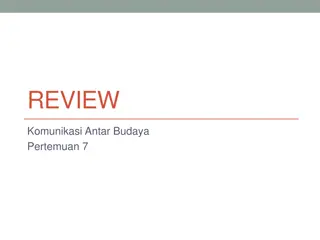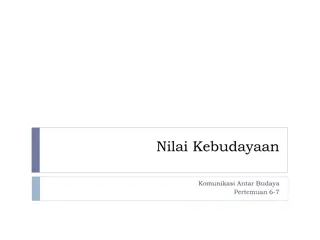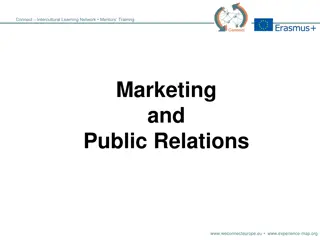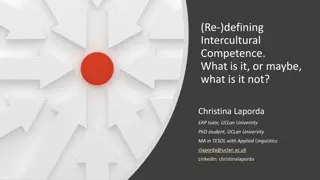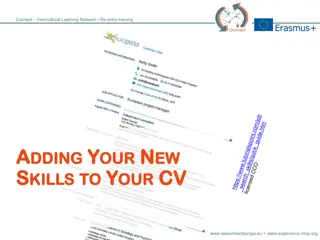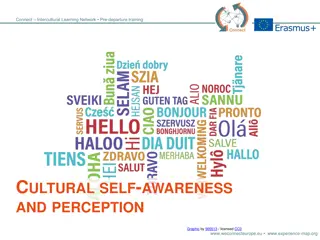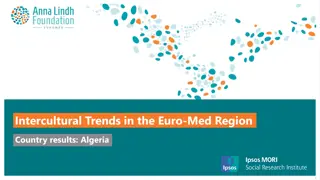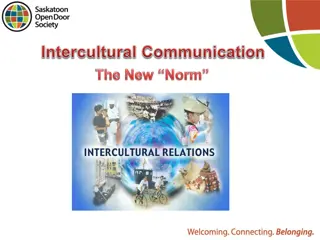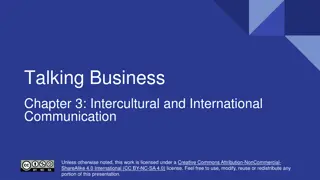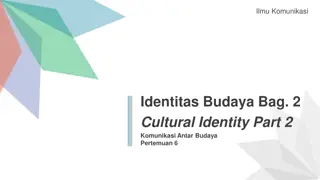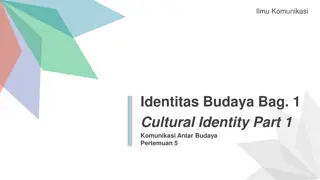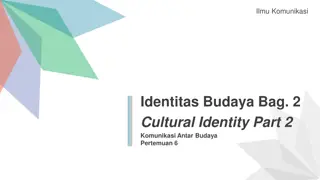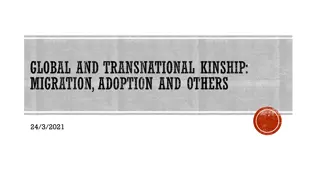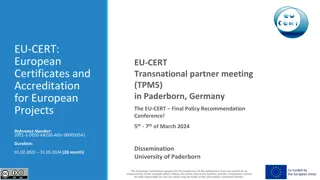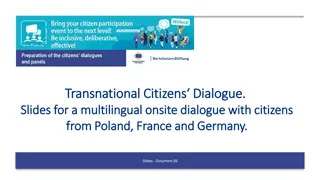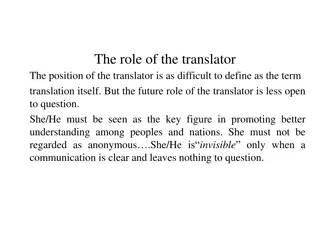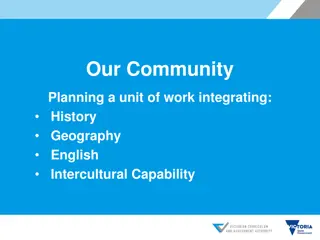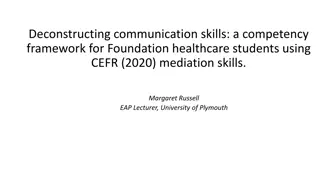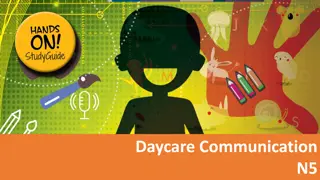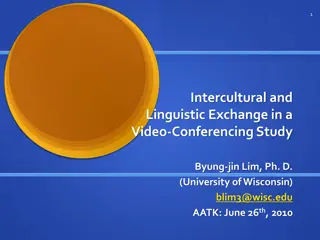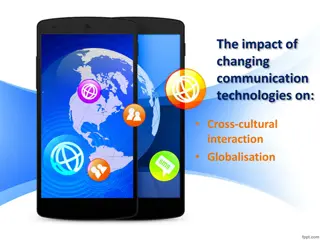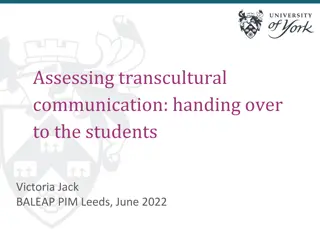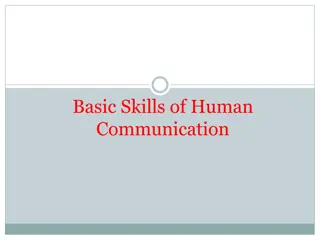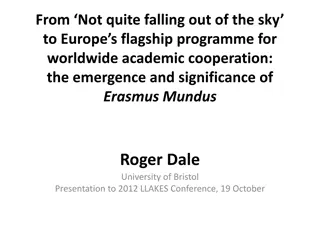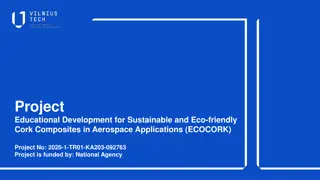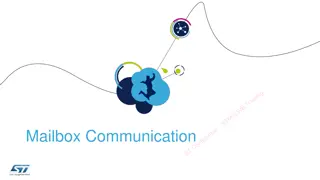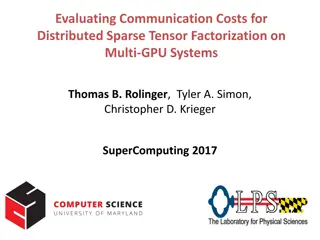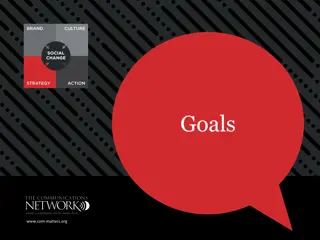Enhancing Intercultural Communication in Transnational Education Settings
This research focuses on the challenges students face in Collaborative Online International Learning tasks within a Transnational Education (TNE) framework. It aims to improve students' soft skills, particularly in intercultural communication, offering insights into the need for English for Specific Academic Purposes (ESAP) support. The study emphasizes the importance of addressing cultural boundaries in an increasingly interconnected labor market, with a specific focus on engineering education and the demand for global communication skills. Recommendations include exploring and enhancing intercultural opportunities in educational contexts to better prepare students for international collaboration.
- Intercultural Communication
- Transnational Education
- Collaborative Online Learning
- ESAP Support
- Global Communication
Download Presentation

Please find below an Image/Link to download the presentation.
The content on the website is provided AS IS for your information and personal use only. It may not be sold, licensed, or shared on other websites without obtaining consent from the author. Download presentation by click this link. If you encounter any issues during the download, it is possible that the publisher has removed the file from their server.
E N D
Presentation Transcript
Developing Intercultural Communication in a Transnational education (TNE) setting: What do students struggle with and can EAP help? Matthew Ketteringham & Joanne Shiel
Overview Context Research Aims IC in a TNE Context Methodology Implications for Future IC Initiatives & EAP Support
Context: EEE Module Level 2 UG Electronic & Electrical Engineering Module: Transistors and Optoelectronics Engineering is truly a global discipline, and in your future careers, you will need to work confidently with colleagues and collaborators all across the world. In this semester, therefore, each of the Chengdu study groups will be partnered with study groups in Leeds. You will then work together, internationally, on your research seminar task: Global Solutions to Photovoltaic Power
Research Aims Identify complex cultural and national boundaries in a Collaborative Online International Learning (COIL) assessed seminar task. students difficulties working across To inform teaching and learning on the EEE module and highlight areas for English for Specific Academic Purposes (ESAP) support to improve students soft skills particularly intercultural communication.
IC in a TNE Context: Rationale Engineering & TNE An increased demand from engineering companies and accreditation bodies for graduates to be able to communicate in a more globalised interconnected labour market (Rico-Garcia & Burns, 2020; Handforth, et al., 2017; Yu, 2011; UK Royal Academy of Engineering, 2007; U.S. National Academy of Engineering, 2004). Ministry of Education (2011) encourages Chinese higher education English language instruction in order to increase learners crosscultural communicative skills and international competitiveness (cited in Hu & Lei, 2014).
IC in a TNE Context: Rationale Collaborative Review Recommendations: Student intercultural opportunities should be explored and enhanced where possible The Joint School is a vehicle for transnational engagement. But currently under-utilised with regard to the opportunities for intercultural communication. Ensure support by the LC is relevant to student needs.
IC in a TNE Context: Soft Skills Engineering education has traditionally focussed on hard skills engineering knowledge, but demand for soft skills is increasing (Gilleard & Gilleard, 2002). Soft Skills : effective communication, teamwork, and problem solving (Deep et al., 2020). Intercultural communication (IC) can be defined as communicating across different cultures (Rico-Garcia & Burns, 2020, p. 834).
IC in a TNE Context: Culture Hofstede (2007, p.16) defines culture as the collective programming of the mind that distinguishes one group or category of people from another . In this study, culture was framed as a given, in this instance, students in the UK and China. Criticisms for being essentialist in nature and taking a reductionist approach (Holliday, 1993, 2013; Handforth, et al. 2017).
IC in a TNE Context: COIL Study/work abroad programmes and language courses have been offered to engineering students to help develop their IC (Yu, 2011). Collaborative Online International Learning (COIL) has been used as an experiential learning pedagogy to aid IC. COIL is a new teaching and learning approach that promotes the development of intercultural competence across shared multicultural learning environments (Rubin, 2015, p.4).
Methodology Case Study. Mixed Methods: Questionnaire, observation of seminars & communication via Teams, Focus groups IC difficulties were identified from previous studies of IC/COIL: Language, Communication, Teamwork, Technology, and Engineering Content A student intern observed the seminars and ran the focus groups
Implications for Future IC Initiatives & EAP Support Experience of IC: 71 % (93% of SWJTU) Technology: Cameras/Mics off WhatsApp, WeChat & QQ Engineering Content: All the students have studied and learnt the same things (Focus Group 1) Small culture (Holliday, 1999) Constructivist view implies: more in common between two engineers from different countries than between an engineer and someone in a very different profession from the same country (Maemura, 2017)
Implications: Language Linguistic Issues: (Focus Group 2): Speaking too fast Lot of short forms for words, whereas we used full forms took a getting used to . It was difficult to understand Leeds students who had a strong accent we weren t familiar . Idiomatic phrases Coping Strategies: Translation, Chat function & Clarification Responsibility for Communication: Raising awareness for both cohorts
Implications: Communication Both cohorts identified problems with communication which they perceived as originating in cultural differences. An interesting comment from a Chinese Leeds-based student was that he did not notice any issues: as he understands the way Chengdu students react and speak in English. He says that the issue is that they don t react in a British way. (Focus Group 1) One problem which a Leeds student highlighted was the Chengdu students not saying they did not understand No one, ever said that they didn t understand, however later it was seen that what was said wasn t understood . (Focus Group 1)
Implications: Teamwork Uneven distribution of work: One student doing all the work. Some Leeds students also felt annoyed that the Chengdu students kept changing their work Critical incidence: UK based Chinese student & SWJTU Student Inter-cohort teamwork could be as much of a problem as intercultural teamwork (academic/institutional culture) Working in Teams - Research first Task Division (Leeds) - Task Division Research (SWJTU)
Student Comments/Feedback Two comments within groups from the different cohorts: I am so happy to see that we can work together to finish this entire large work. Although we are lack of people, I do think we made this challenge, and finally produced a good work. (SWJTU) I thought it was a great experience as well. I hope to work with this international seminar group again. (Leeds)
Conclusion Lack of IC opportunities Small cultures approach Language & Communication Teamwork Possible joint marking with EEE Module Lead Increase COIL initiatives to develop IC across Engineering Faculty
References Deep, S., Ahmed, A., Suleman, N., Abbas, M., Nazar, U., and Razzaq, A. 2020. The Problem-Based Learning Approach towards Developing Soft Skills: A Systematic Review. The Qualitative Report. 25(11), pp. 4029-4054. Gilleard, J and Gilleard, J.D. 2002. Developing Cross Cultural Communication Skills. Journal of Professional Engineering education and Practice. 128 (4), pp197-200. Handford, M., Maele, J.V., Matous, P. and Maemura, Y. 2017. Which culture ? A critical analysis of intercultural communication in engineering education. Journal of Engineering Education. 108, pp.161-177. Hofstede, G. 2007. A European in Asia. Asian Journal of Social Psychology. 10(1), pp.16-21. Holliday, A. (1999). Small cultures. Applied Linguistics. 20(2), pp. 237 264. Holliday, A. (2013). Understanding intercultural communication: Negotiating a grammar of culture. London, England: Routledge. Hu, G., & Lei, J. (2014). English-medium instruction in Chinese higher education: A case study. Higher Education, 67, pp. 551 567. Rico-Garcia, M. and Burns, L.V.F. 2020. Intercultural communication in engineering studies: a key competence in global labour markets. European Journal of Engineering Education. 45(6), pp.833-853 Royal Academy of Engineering. 2007. Educating Engineering for the 21stCentury. London: Royal Academy of Engineering. Available from: https://www.raeng.org.uk/publications/reports/educating-engineers-21st-century Rubin, J. (2015).Faculty guide for collaborative online international learning course development. http://www.ufic.ufl.edu/UAP/Forms/COIL_guide.pdf U.S. National Academy of Engineering. (2004). The engineer of 2020: Visions of engineering in the new century. Washington, DC: The National Academies Press. Available from: https://nap.nationalacademies.org/catalog/10999/the-engineer-of-2020-visions- of-engineering-in-the-new Yu, H. 2011. Integrating Intercultural Communication into an Engineering Communication Service Class. IEEE Transactions on Professional Communication. 54(1), pp.83-96.


